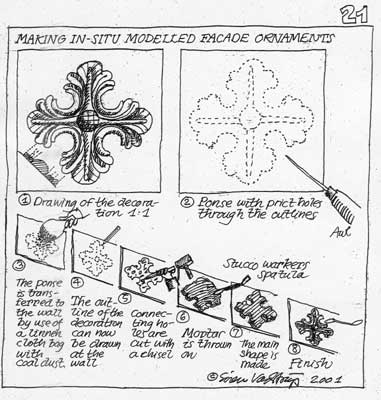Working
Techniques and Repair Methods for Plaster Decorations on Facades
By: Søren Vadstrup
7. In-situ modelled
decorations in plaster on facades

In-situ hand modelling of plaster
decorations on facades is a very old crafts technique belonging to the
stucco workers profession.
Typical hand modelled elements can
be consoles, festoons, medallions, animal heads, column capitals, etc.
See examples on drawing 1 and 21.
First a full scale drawing of the
decoration, either produced by the craftsman, an artist or the architect,
is made on paper, which is impregnated with a coat of shell lacquer. This
is however not always necessary, if the paper is sufficiently strong and
stiff. Now the outline of the figure is riddled with an awl, making small
holes through the paper, now called a ponse.
With a little slightly un-tight linen
bag, filled with charcoal-dust, the black powder is sprinkled over the
ponse and through the pricked holes in the paper. This of cause is done
at the exact place for the decoration at the facade, and when the ponse
is removed, the contours of the decoration is nicely transferred to the
surface.
The outlines are drawn up and the
application of mortar prepared by cutting grooves in the surface and the
contour with a chisel. After the usual pre-watering of the ground, the
mortar, preferably a medium fine hydraulic lime mortar (1:2:9), is thrown
on. Now first the exact outline and next the details of the decoration
are hand modelled with the use of stucco workerís tools: various round,
square and hollow spatulas.
If the construction is thicker than
5 - 6 cm it is recommended to use two separate layers of mortar, as previously
described. The binding to the ground will also in that case have to be
reinforced with laths in stainless steel.
Index
|

